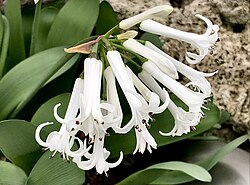Biology:Strumaria phonolithica
| Strumaria phonolithica | |
|---|---|

| |
| Cultivated specimen, Davies Alpine House, Kew Gardens | |
| Scientific classification | |
| Kingdom: | Plantae |
| Clade: | Tracheophytes |
| Clade: | Angiosperms |
| Clade: | Monocots |
| Order: | Asparagales |
| Family: | Amaryllidaceae |
| Subfamily: | Amaryllidoideae |
| Genus: | Strumaria |
| Species: | S. phonolithica
|
| Binomial name | |
| Strumaria phonolithica Dinter
| |
| Synonyms[2] | |
|
Strumaria gigantea D.Müll.-Doblies & U.Müll.-Doblies | |
Strumaria phonolithica is an Amaryllidaceous plant species (tribe Amaryllideae) endemic to Namibia.[3] Its narrow funnel-shaped flowers are, jointly with those of Strumaria barbarae, the largest in the genus. It grows in subtropical shrubland, tropical dry shrubland and rocky areas in the Aurus and Klinghardt Mountains of the Tsau ǁKhaeb Sperrgebiet National Park in southwestern Namibia, where it is usually to be found growing in phonolite gravels (- whence the specific name phonolithica) [4][5][6]
Growth habit
Although the plants occur in large clumps, this is not the result of vegetative reproduction : the bulbs are solitary and thus do not form daughter bulbs (offsets), the clumps forming as a result of seeds (from sexual reproduction) germinating close together. [4]
References
- ↑ Craven, P.; Loots, S. (2004). "Strumaria phonolithica". IUCN Red List of Threatened Species 2004: e.T46718A11077559. doi:10.2305/IUCN.UK.2004.RLTS.T46718A11077559.en. https://www.iucnredlist.org/species/46718/11077559. Retrieved 17 November 2021.
- ↑ "Strumaria phonolithica Dinter". The Trustees of the Royal Botanic Gardens, Kew. n.d.. https://powo.science.kew.org/taxon/urn:lsid:ipni.org:names:66918-1.
- ↑ Kew World Checklist of Selected Plant Species
- ↑ Jump up to: 4.0 4.1 South African National Biodiversity Institute, plantzafrica.com https://pza.sanbi.org/strumaria-phonolithica Retrieved at 8.34 on Tuesday 14/11/23.
- ↑ Grossi, Alberto (2014), "Strumaria in cultivation", The Plantsman, (New Series) 13 (4): 222–225
- ↑ Dinter, Moritz Kurt. 1923. Repertorium Specierum Novarum Regni Vegetabilis 19: 178.
Wikidata ☰ Q5417940 entry
 |


